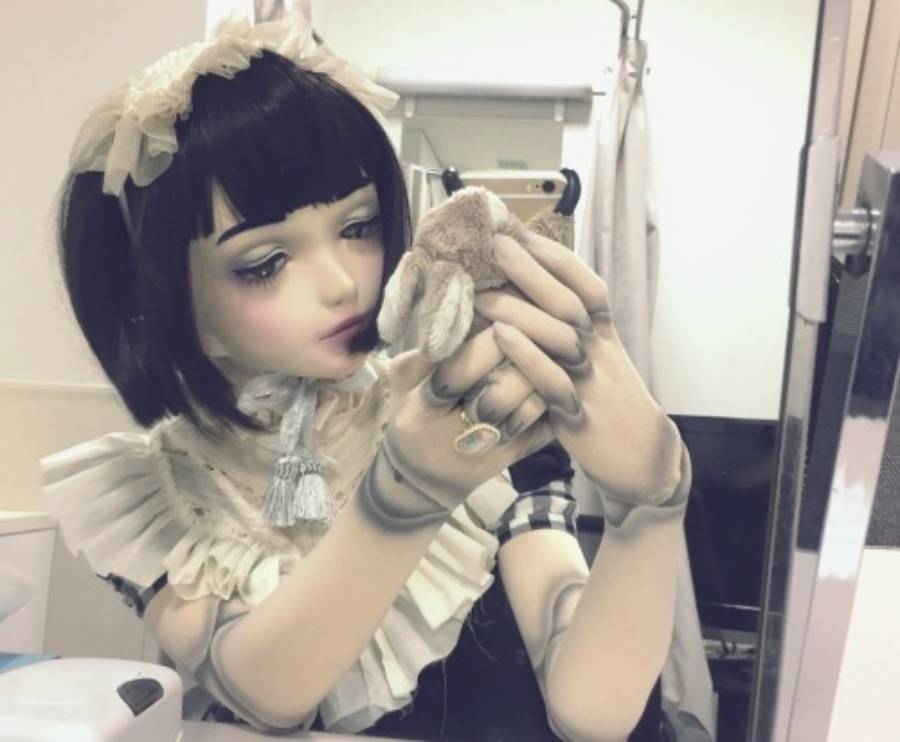Lulu Hashimoto is a Japanese fashion model from Tokyo. She’s attracted tens of thousands of followers on social media since debuting in the Japanese fashion modeling scene in 2016. Lulu has appeared on magazine covers and in both print and video interviews. In 2017 she even contested the unconventional Miss iD beauty pageant. Yet, Lulu Hashimoto is not a real person.
Lulu Hashimoto – the “living doll” fashion model
Lulu Hashimoto is the brainchild of Japanese fashion designer Hitomi Komaki (who also goes by the moniker “millna”). The fiction surrounding Lulu Hashimoto is that she is “half-person, half doll.” Though she’s really an elaborate full-body suit consisting of a detailed mask, a wig, and stockings designed by Koh Ueno. The stockings appear as articulated legs like those of a doll.
Lulu’s creator can change the doll’s wig, makeup, and even her height. Komaki says that she found the inspiration to create Lulu Hashimoto because of her love of dolls. She said that to her, “dolls are the epitome of cuteness.” She states that donning the Lulu Hashimoto costume is “like wearing nice clothes or putting on false eyelashes to become cuter.”
However, Hitomi Komaki does not actually wear the Lulu Hashimoto costume – that job falls to unidentified models, dancers, and designers. Nobody knows exactly who has the Lulu Hashimoto costume on at any given time.
What is kigurami?
Lulu Hashimoto is an example of what is known in Japan as kigurami or a “doller.” This is a type of cosplay (the art of dressing up in a costume to portray a specific character.) It involves wearing a costume to portray an anime or cartoon character (or, in Lulu’s case, a doll). Kigurami differs from other forms of cosplay in that the costume always involves completely hiding one’s face with a mask. Practitioners wear a bodysuit called a zentai suit. Kigurami is used most frequently in stage shows in Japan, where performers will dress up as specific anime characters. Hobbyists also enjoy creating their own characters and consider it an art form.
Miss iD – a unique kind of beauty pageant
In 2017, Lulu Hashimoto entered the Miss iD beauty pageant. She made the semi-finals. The annual pageant focuses on contestants with more of a “unique” look. According to the organizers of the pageant (sponsored by publishing agency Kodashana), attracts “all you young girls out there who have ever hesitated to apply for typical auditions and casting calls for models, actresses, and idols. If you’ve ever wanted to make this boring world a more fun place, we want to meet the true you.”
The pageant attracts around four thousand entrants each year, whittled down to three hundred selected to audition. There is no “one way” to pass the audition process – as the design of the competition centers on the concept of uniqueness, competitors must show off their strange and unusual talents.
One contestant from 2016, Amina du Jean, demonstrated her extensive collection of anime figurines and got through to the competition. Online voters decide on the winner of the competition who receives a photo in Miss iD’s photobook, a big boost to their career.
2017, the year that Lulu Hashimoto entered the competition, was the first year that the organizers accepted “non-human” entrants – including contestants created via artificial intelligence or 3-D computer graphics.
More than just a costume
The concept of Lulu Hashimoto goes beyond just dressing up in a doll costume. Lulu has her own personality, interests, and goals. When she has interviewed for magazines or videos, the interviewer chats with her as if she were a real living doll. Lulu reveals details about her “life.”
A video interview with Cathy Cat for Japanese magazine Melt, for example, reveals Lulu Hashimoto’s fictional life. Because she is a living doll Lulu “naturally doesn’t gain weight easily” and loves to change her hair color frequently. Like many people, Lulu’s routine before bed includes having a nice cup of hot tea. When not busy causing a stir in the fashion modeling scene, Lulu keeps busy by practicing her ballet dancing, reading books, and listening to music (she likes the Japanese pop group Spank Happy). Lulu even has defined hopes and dreams – in 2017; her wish was to “walk down the catwalk.”
Read more: Habu Sake: The Cruelly Produced Snake Wine
These details help transform Lulu Hashimoto from a costume into a real living doll that tens of thousands of fans want to get to know. Erika Kato, a fan who met Lulu at a fan event, gushed over the experience, stating that she found it “miraculous that dolls and humans – two things that exist in different planes – stand in the same space.”
Lulu’s kawaii (the Japanese word for “cute” and also a fashion movement) style has also garnered her a strong group of followers, with one fan, a woman named Miu Shimoda, saying that she would “like to be a beautiful girl like Lulu at least once in my life.”


